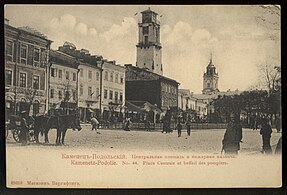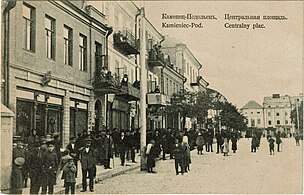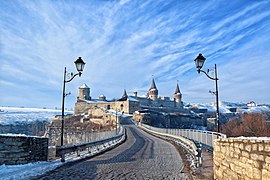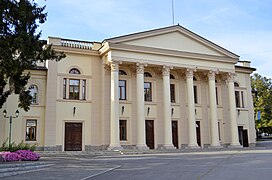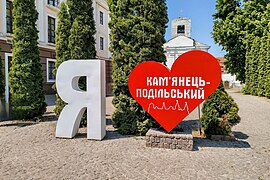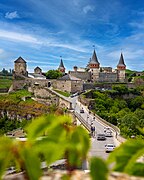Kamianets-Podilskyi
This article needs additional citations for verification. (July 2023) |
You can help expand this article with text translated from the corresponding article in Ukrainian. (July 2022) Click [show] for important translation instructions.
|
Kamianets-Podilskyi
Кам'янець-Подільський | |
|---|---|
|
UTC+3 (EEST) | |
| Postal code | 32300—32318 |
| Area code | +380-3849 |
 | |
Kamianets-Podilskyi (
Kamianets-Podilskyi is a historical center of Podolia region, serving as a capital of Podillia Duchy, Podolian Voivodeship, Podolia Governorate following Russian occupation, Podolia vilayet during Ottoman occupation. During the Ukrainian–Soviet War, the city officially served as the temporary capital of the Ukrainian People's Republic from 1919 to 1920.[3]
Name
Originally known as Kamianets, its name was changed to the current following the partitions of Poland and occupation by the Russian Empire in 1795.
The first part of the city's dual name originates from kamin' (Ukrainian: камiнь) or kamen, meaning 'stone' in Old Slavic. The second part of its name relates to the historic region of Podilia (Ukrainian: Подíлля), of which Kamianets-Podilskyi is considered to be the historic capital. Therefore, the town name literally means 'The Stones of Podilia'.
Equivalents of the name in other languages are
Geography
Kamianets-Podilskyi is located in the southern portion of the
The
History
Classical antiquity
Several historians consider that a city on this spot was founded by the ancient
Kyivan Rus and the Tatars (11th c.–1241)

Modern Kamianets-Podilskyi was first mentioned in 1062, when it belonged to smaller principalitie of
Polish rule (1352–1672)
In 1352, it was inherited by the
During the
).Ottoman rule (1672–1699)
After the
Polish–Lithuanian Commonwealth (1699–1793)

In 1699, the city was given back to Poland under King Augustus II the Strong according to the Treaty of Karlowitz. The fortress was continually enlarged and was regarded as the strongest in the Polish–Lithuanian Commonwealth. The preserved ruins of the fortress still contain the iron cannonballs stuck in them from various sieges.
During this period,
Russian rule (1793–1915)
After the
According to the
-
Lithograph of Napoleon Horda between 1862 and 1876
-
Kamianets-Podilskyi fortress 1865
-
Kamenets from a height, the beginning of the 20th century
-
Church of St. Nicholas, 1902
-
Polish market, centralny plac, 1906
-
Centralny plac, 1906-1910
-
Postova Street, to the right of the Jewish shops, Old Town, 1910
-
Kamianets-Podilskyi aerial survey, 1914
-
Austro-Hungarian troops enter the Kamianets-Podilskyi, 1918
-
Kamianets-Podilsky bridge, 1918
World War I and post-war tribulations

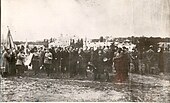
During World War I, the city was occupied by Austria-Hungary in 1915.
After the
During the
administration from 16 November 1919, to 12 July 1920.In July 1920 battles between units of the
Soviet occupation[19][20] (1921-1991)
After the defeat of the

In December 1927,

The
During the years of the

Following the
A structural network of the OUN functioned on the territory of the city: Kamianets-Podilsky District, which belonged to the UPA-South. During the German occupation, Ukrainian national forces formed local self-government bodies: the regional administration, the regional department of education. Hryhoriy Kybets was appointed the head of the regional administration.[30]
In January 1942, the Nazis began mass arrests and executions of people from Bandera in Kamianets-Podilskyi, more than 150 Ukrainian nationalists were shot.
In 1944-45, the 19th tactical division of the Kamianets UPA, the Lysonya military district, and the UPA-West military group operated on the territory of Kamianechchyna in 1944-45. The department was later divided into two parts in the summer of 1945. And self-defense bush units of the UPA from Ternopil Oblast also went on raids.[31]
In 1986, the population of the city reached 100,000 people, according to this indicator, Kamianets moved from the category of medium to large cities.
On October 16, 1990, a rally was held in the city in support of the students of Kyiv, who announced a hunger strike as a sign of protest against the government's policies. In the central square of the city, the demands of the students to the Verkhovna Rada of the Ukrainian SSR regarding the adoption of laws on local self-government and the non-signing of the Union Treaty, and to the City Council regarding the raising of the blue-yellow flag were approved. On October 16, the presidium of the city council satisfied the students' demand and was the first in Khmelnytskyi to raise the national flag.[32]
Independent Ukraine[33]

On 16 July 1990, the new Ukrainian parliament adopted a declaration of sovereignty.[34]
On 16 January 1991, Pope John Paul II re-established the Roman Catholic Diocese of Kamyanets-Podilskyi, which was dissolved under Soviet occupation.
Since August 24, 1991, Kamianets-Podilskyi has been part of independent Ukraine and is a significant economic, cultural, educational and tourist center of the state.[35][36][37]

In 2004, residents of the city actively participated in the Orange Revolution, people held rallies on the Renaissance Square.[38]
On December 1, 2013, city students from the Ivan Ohienko National University, Podilsk State Agrarian and Technical University and other educational institutions protested in the city, marching in a column through the streets and forming a viche near the city council, they expressed their anger at the authorities for their arbitrariness.[39]

In the future, many residents of the city gathered every day for vigils under the city council to express their protests against the regime and to support the Euromaidan in Kyiv. The largest rally in terms of numbers took place on January 26, 2014, about 2,000 people took part in it.[41][42][43]
As of 2015[update], Kamianets-Podilskyi was the third-largest city of Podolia after
Until 18 July 2020, Kamianets-Podilskyi was incorporated as a city of oblast significance and served as the administrative center of Kamianets-Podilskyi Raion though it did not belong to the raion. In July 2020, as part of the administrative reform of Ukraine, which reduced the number of raions of Khmelnytskyi Oblast to three, the city of Kamianets-Podilskyi was merged into Kamianets-Podilskyi Raion.[45][46][47]
Jewish history
During the Khmelnytsky Uprising (1648–58), the Jewish community of Kamianets-Podilskyi suffered much from Khmelnytsky's Cossacks on the one hand, and from the attacks of the Crimean Tatars (their main object being the extortion of ransoms) on the other.[48]


About the middle of the 18th century, Kamianets-Podilskyi became celebrated as the center of the furious conflict then raging between the Talmudic Jews and the
Kamianets-Podilskyi was also the residence of the wealthy Joseph Yozel Günzburg. During the latter half of the 19th century, many Jews from Kamianets-Podilskyi emigrated to the United States, especially to New York City, where they organized a number of societies.[48]
One of the first and largest
Population
According to the data of the first all-Ukrainian population census in 2001, the population of the city was 99,610 people.[53]
Language
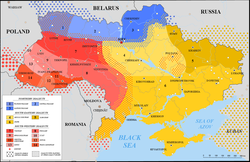
The city is located on the territory of the Podilian dialect, which belongs to the group of Volhynian-Podilian dialects of the southwestern group. The West-Podilian dialect, which has common features with the Dniestrian Ukrainian dialect, and the South-Podilian dialect, which has common features with the Pokuttia–Bukovina dialect, are common in the city.[54][55][56] Kamianets-Podilskyi is included in the "Atlas of the Ukrainian Language".[57]
Distribution of the population by native language according to the 2001 census:[58]
| Language | Percentage |
|---|---|
| Ukrainian | 91.22% |
| Russian | 7.08% |
| other/undecided | 1.7% |
Religion
All major religious groups in Ukraine are represented in the city, a large part of Kamianets residents are Catholics, many are Orthodox.[59] Throughout history, various Catholic monastic orders have functioned in Kamianets-Podilskyi: Dominicans, Franciscans, Jesuits, Capuchins, Discalced Carmelites, Brothers Hospitallers of Saint John of God, Trinitarians, and as of 2023, the city has Pauline orders and the Society of Christ.[60]
-
Trinity Church
-
The refectory of the Dominican monastery
-
Church of Saints Peter and Paul
-
Church of the Holy Apostles Peter and Paul
-
Zdvychensk church
Climate
| Climate data for Kamianets-Podilskyi (1981–2010) | |||||||||||||
|---|---|---|---|---|---|---|---|---|---|---|---|---|---|
| Month | Jan | Feb | Mar | Apr | May | Jun | Jul | Aug | Sep | Oct | Nov | Dec | Year |
| Mean daily maximum °C (°F) | −0.3 (31.5) |
1.4 (34.5) |
7.0 (44.6) |
14.9 (58.8) |
21.2 (70.2) |
23.7 (74.7) |
25.7 (78.3) |
25.2 (77.4) |
19.9 (67.8) |
13.7 (56.7) |
6.0 (42.8) |
0.6 (33.1) |
13.3 (55.9) |
| Daily mean °C (°F) | −3.3 (26.1) |
−2.2 (28.0) |
2.4 (36.3) |
9.2 (48.6) |
15.1 (59.2) |
17.9 (64.2) |
19.8 (67.6) |
19.0 (66.2) |
14.1 (57.4) |
8.6 (47.5) |
2.7 (36.9) |
−2.1 (28.2) |
8.4 (47.1) |
| Mean daily minimum °C (°F) | −6.4 (20.5) |
−5.5 (22.1) |
−1.7 (28.9) |
3.9 (39.0) |
9.3 (48.7) |
12.4 (54.3) |
14.2 (57.6) |
13.4 (56.1) |
9.1 (48.4) |
4.3 (39.7) |
−0.3 (31.5) |
−5.0 (23.0) |
4.0 (39.2) |
| Average precipitation mm (inches) | 31.2 (1.23) |
34.7 (1.37) |
30.9 (1.22) |
46.3 (1.82) |
64.3 (2.53) |
92.6 (3.65) |
96.8 (3.81) |
61.1 (2.41) |
54.1 (2.13) |
38.5 (1.52) |
37.9 (1.49) |
37.5 (1.48) |
625.9 (24.64) |
| Average precipitation days (≥ 1.0 mm) | 7.7 | 7.6 | 7.2 | 7.6 | 9.2 | 9.8 | 10.3 | 7.5 | 7.5 | 6.6 | 7.0 | 8.1 | 96.1 |
| Average relative humidity (%)
|
85.3 | 82.9 | 76.6 | 68.0 | 67.5 | 72.7 | 73.5 | 73.6 | 77.3 | 80.7 | 85.3 | 86.4 | 77.5 |
| Mean monthly sunshine hours | 39.2 | 64.3 | 121.2 | 168.1 | 241.9 | 237.5 | 241.4 | 234.6 | 162.7 | 103.8 | 48.9 | 62.7 | 1,696.3 |
| Source: World Meteorological Organization[61] | |||||||||||||
Culture
Main sights

The different peoples and cultures that have lived in the city have each brought their own culture and architecture. Examples include the Polish, Ruthenian and Armenian markets.[11] Famous tourist attractions include the ancient castle, and the numerous architectural attractions in the city's center, including the cathedral of Saints Peter and Paul, Holy Trinity Church, the city hall building, and the numerous fortifications.

Since the late 1990s, the city has grown into one of the chief
"Respublica" Festival is a music and art festival for youth featuring modern music, literature, and street art. This festival is held annually, gathering hundreds of young art lovers, musicians, and art enthusiasts. Many of the city's buildings are decorated with murals, created during these festivals. The murals depict historical events, as well as modern concepts.
Twin towns and sister cities
Kamianets-Podilskyi is
 Dolný Kubín, Slovakia
Dolný Kubín, Slovakia Kalisz, Poland[63]
Kalisz, Poland[63]- Zalau, Romania
 Brantford, Canada[64]
Brantford, Canada[64] Wiesbaden, Germany[65]
Wiesbaden, Germany[65]
Kamianets-Podilskyi's other sister cities are:
|
Notable residents







- Mikhail Alperin (born 1956), Ukrainian jazz pianist.
- Maria Berlinska (born 1988), Ukrainian military volunteer and women's rights advocate, born here.
- Andriy Bondar (born 1974), Ukrainian poet, translator and writer.
- Andrei Bondarenko (born 1987), Ukrainian operatic baritone, born here.
- Chebotaryov density theorem.
- Moisey Gamarnik (born 1936), Soviet and Ukrainian physicist and inventor, born here.
- Mykhailo Hrushevsky (1866–1934), Ukrainian academician, politician, historian and statesman, one of the most important figures of the Ukrainian national revival of the early 20th century, lived and worked in universaty here.
- Sergey Gorshkov (1910–1988), Russian and Soviet Admiral of the fleet of the Soviet Union, born here.
- Ilarion Ohienko (1882–1972), Ukrainian Orthodox cleric, linguist, church historian, and historian of Ukrainian culture. In 1919, he was Minister of Education in the Ukrainian People's Republic (UPR) and first rector of Kamianets-Podilskyi State Ukrainian University.
- striker for Dynamo Kyiv, born here.
- Vasyl Matviychuk (born 1982), Ukrainian long-distance runner.
- UNR Army, born here
- UNR Army, born here.
- Marko Mazurenko (1871–1929), corporal general of the Army of the Ukrainian People's Republic, born here.
- David Günzburg (Baron de Günzburg; 1857–1910) Russian orientalist and Jewish communal leader, born here.
- Israel J. Hochman (1872–1940), American klezmer violinist and recording artist, born here.
- Sergius Ingerman (1868–1943), American physician and socialist, born here.
- Józef Kallenbach (1861–1929), Polish historian of literature, born here .
- Yuriy Khimich (1928–2003), a Ukrainian painter, born here.
- Andrii Klantsa (born 1980), cardiac surgeon, scientist, Merited Doctor of Ukraine, Doctor of Science in Public Administration.
- Stanisław Koniecpolski (1590 or 1594–1646), Polish military commander, fought here.
- Yevhen Petrushevych (1863–1940), Ukrainian lawyer, politician, and president of the West Ukrainian People's Republic, lived and worked here, when WUPR government settled in Kamianets-Podilskyi.
- Myron Tarnavsky (1869–1938), Ukrainian supreme commander of the Ukrainian Galician Army, the military of the West Ukrainian People's Republic, fought here
- Mark Kopytman (1929–2011), Soviet-Israeli composer, musicologist, and pedagogue, born here.
- Murray Korman (1902–1961), American publicity photographer.
- Leib Kvitko (1890–1952), Yiddish poet, author of children's poems, and member of the Jewish Anti-Fascist Committee.
- Mykola Leontovych (1877–1921), Ukrainian composer, studied and graduated from the city's Theological Seminary.
- Iryna Merleni (born 1982), female wrestler.
- Aleksander Michałowski (1851–1938), Polish pianist, born here.
- Mieczysław Mickiewicz (1879–before 1939), Polish politician, born here.
- Szymon Okolski (1580–1653), Polish historian, lived here.
- Ferdynand Antoni Ossendowski (1876—1945), Polish writer, explorer, professor, anti-communist and political activist; lived here.
- Morris Schappes (1907–2004), American educator, writer, radical political activist, historian, and magazine editor.
- Zvee Scooler (1899–1985), actor and radio commentator, best known as the Rabbi in Fiddler on the Roof; born here.
- Mendele Mocher Sforim (1836–1917), Jewish author; lived here
- Leo Sirota (1885-1965), Jewish pianist .
- Samuel Spielberg, Steven Spielberg's paternal grandfather.
- Mihail Starenki (1879–?), Bessarabian politician born here.
- Leonid Stein (1934–1973), Soviet chess Grandmaster, born here.
- Paul Burman (1888–1932), Estonian painter and graphic artist of Baltic German descent, born here.
- Moshe Stekelis (1898–1967), Russian-Israeli archaeologist .
- Arthur Tracy (1899–1997), American singer, born here.
- Anton Vasyutinsky (1858–1935), painter, coin and medal designer, born here.
- Mikhail Veller (born 1948), Russian-Estonian writer, born here.
- Ion Vinokur (1930–2006), Ukrainian archaeologist, historian, lived and worked here.
- Jan de Witte (1709–1785), Polish architect and commander of the local fortress.
- Jerzy Wołodyjowski, Polish colonel, prototype for one of Henryk Sienkiewicz's characters, Michał Wołodyjowski; killed here.
- Oleksandr Zaremba (born 1978), Ukrainian historian, military reenactor, festival organizer, and civic activist.
- Józef Zajączek (1752–1826), Polish general, born here.
- Maurice Zbriger (1896–1981), Canadian violinist, composer, and conductor, born here.
- Isidor Zuckermann (1866–1946), Austrian businessman.
- Jan Olszanski (1919–2003), Ukrainian Roman Catholic prelate as the first diocesan Bishop of the reestablished Roman Catholic Diocese of Kamyanets-Podilskyi from 16 January 1991 until his retirement on 4 May 2002.
Gallery
-
Fortetsya str. Zamkova
-
Frozen waterfall
-
Novoplanivskyi Bridge
-
Armenian Bell Tower
-
House of Culture
-
Sculpture of the Mother of God
-
Orthodox church
-
Stephen Báthory Tower
-
Art object "I love Kamianets-Podilskyi"
-
Pyatnytska Street
-
Fortress walls
-
Triumphal Arch
-
The impregnable fortress
-
Fortress, 2023
-
Fortress at dawn
-
Fortress
-
Residential building str. Lesya Ukrainka
-
References
- ^ a b Чисельність наявного населення України на 1 січня 2022 [Number of Present Population of Ukraine, as of January 1, 2022] (PDF) (in Ukrainian and English). Kyiv: State Statistics Service of Ukraine. Archived (PDF) from the original on 4 July 2022.
- ^ "Каменец-Подольская городская громада" (in Russian). Портал об'єднаних громад України.
- ^ Pustynnikov, Iryna. The last capital of Ukrainian People's Republic (Остання столиця УНР). Newspaper "Den". 14 October 2011
- ^ Beider, Alexander (2012). "Eastern Yiddish Toponyms of German Origin" (PDF). Yiddish Studies Today. ISBN 978-3-943460-09-4, ISSN 2194-8879 (düsseldorf university press, Düsseldorf 2012). Retrieved 26 December 2023.
- ^ Holocaust Museum, "Kamenets-Podolsk".
- ^ a b "Geography". kp.rel.com.ua (in Ukrainian). Archived from the original on 28 September 2007. Retrieved 25 October 2007.
- ^ a b "The Museum City". Kamianets-Podilskyi. Art/Ukrainian. Archived from the original on 12 October 2007. Retrieved 26 October 2007.
- ^ "Perła Podola". niedziela.pl (in Polish). Archived from the original on 22 May 2011. Retrieved 26 October 2007.
- ^ Kamianets-Podilskyi
- ^ Kyiv not Kiev: Why spelling matters in Ukraine’s quest for an independent identity
- ^ a b c "History". kp.rel.com.ua (in Ukrainian). Archived from the original on 28 September 2007. Retrieved 25 October 2007.
- ^ An Urban History of Early Modem Karnianets-Podilsky, Origins to 1672
- ^ The Eyalet of Kamaniçe, map. Accessed 7 Jan. 2021.
- ^ Rodkinson, Michael Levi (1918). The history of the Talmud from the time of its formation, about 200 B.C., up to the present time. The Talmud Society. pp. 100–103.
- ISBN 9789004376731.
- ^ Historisna Pravda(3 June 2019)
- ^ Historisna Pravda(27 August 2019)
- ^ Historisna Pravda(23 August 2021)
- ^ Soviet Ukraine in a Nutshell
- ^ Ukrainian-Soviet War, 1917–21
- ^ Ukrainian Insurgent Army
- TIME Magazine, 12 December 1927
- ^ Документи Держархіву Хмельницької області
- ^ Kamianets-Podilskyi, Ukraine
- ^ Holodomor History
- ^ Голодомор 1932—1933 Років: «Червоні Мітли» Проти Українського Селянства
- ^ Polish - Ukrainian Cooperation
- ^ Great Terror
- ^ Davis, Martin, ed. (2010). "The Nazi Invasion of Kamenets". JewishGen.
- ^ [https://ephd.cz/wp-content/uploads/2017/ephd_2017_3_4/07.pdf ACTIVITY OF THE KAMIANETS-PODILSKYI NADRAYONNYI PROVID OF THE OUN (B) IN 1948–1952]
- ^ Ukrainian Liberation Movement in Central Eastern Podillya in the 40-50s of the 20th Century in Ukrainians Memory
- ^ Kamyanec-Podilsky
- ^ Independent Ukraine
- ^ "Declaration of State Sovereignty of Ukraine". Verkhovna Rada of Ukraine. 16 July 1990. Archived from the original on 27 September 2007. Retrieved 12 September 2007.
- ^ 11 Independent Ukraine
- ^ KAMIANETS PODILSKYI – AN UNDERRATED GEM OF UKRAINE
- ^ Kamianets-Podilskyi. The living fortress
- ^ How Ukraine’s Orange Revolution shaped twenty-first century geopolitics
- ^ K-PNU’s Anniversary
- ^ Fourteen Euromaidan and the echoes of the Orange Revolution: comparing social infrastructures and resistance practices of protest camps in Kiev (Ukraine)
- ^ Ukraine's revolution of dignity: The dynamics of Euromaidan
- ^ Heroes Euromaidan royalty-free images
- ^ Understanding Ukraine’s Euromaidan Protests
- ^ «У центрі Кам’янця з’явиться Європейський сквер із неоновою підсвіткою та геометричними клумбами»
- ^ "Про утворення та ліквідацію районів. Постанова Верховної Ради України № 807-ІХ". Голос України (in Ukrainian). 18 July 2020. Retrieved 3 October 2020.
- ^ "Нові райони: карти + склад" (in Ukrainian). Міністерство розвитку громад та територій України.
- ^ KAMIANETS-PODILSKYI
- ^ a b c "Kamenetz-Podolsk". JewishEncyclopedia.com. Retrieved 8 July 2009.
- ISBN 978-0465002399.
- ^ Martin Davis. "Kamyanets-Podilskyy" (PDF). Gladys and David Blank's Genealogy. pp. 11-14 / 24 in PDF – via direct download. Also in: Martin Davis (2010). "The Nazi Invasion of Kamenets". JewishGen.
- ISBN 0814326919.
- ^ Gross, S.Y.; Cohen, Yosef, eds. (1983). "Chapter 7 - The Holocaust of Jewish Marmaros". The Marmaros Book - In Memory of 160 Jewish Communities. Tel Aviv: Beit Marmaros.
- ^ All-Ukrainian Population Census 2001 - IPUMS Subset
- ^ Ukrainian dialects: history, geography, and examples
- ^ WESTERN UKRAINIAN DIALECTS
- ^ What is the Ukrainian language?
- ^ Атлас української мови: в трьох томах. Т. 2. Волинь, Наддністрянщина, Закарпаття і суміжні землі / АН Української РСР, Ін-т мовознавства ім. О. О. Потебні (К.). — К.: Наукова думка, 1988. — 520 с.
- ^ "Рідні мови в об'єднаних територіальних громадах України".
- ^ КАМ'ЯНЕЦЬ-ПОДІЛЬСЬКА ДІЄЦЕЗІЯ
- ^ CHURCH, SPIRITUALITY, NATION:THE UKRAINIAN GREEK-CATHOLIC CHURCH IN THE SOCIAL LIFE OF UKRAINE
- ^ "World Meteorological Organization Climate Normals for 1981–2010". World Meteorological Organization. Archived from the original on 17 July 2021. Retrieved 17 July 2021.
- ^ "Фестиваль повітряних куль 2020 у Камянці-Подільському!. Афіша Хмельницького - moemisto.ua". moemisto.ua (in Ukrainian). Retrieved 29 December 2020.
- ^ "Kalisz Official Website – Twin Towns" (in Polish). Archived from the original on 25 September 2011. Retrieved 29 November 2008.
- ^ "Brantford signs twinning agreement with Ukrainian city". Kitchener. 4 April 2022. Retrieved 29 April 2022.
- ^ Bock, Oliver (12 September 2023). "Eine ukrainische Partnerstadt für Wiesbaden". faz.net (in German). Oliver Bock. Retrieved 12 October 2023.
Sources
- Olha Plamenytska, ed. (2003). Tourist guide Kamianets-Podilskyi (in Ukrainian). ISBN 966-7022-46-3. Archived from the originalon 16 November 2007.
External links
- "Kamianets-Podilskyi information site". kam-pod.info. Archived from the original on 22 July 2010. Retrieved 26 October 2013.
- Official website
- "The old fortress on the Smotrich River," in Dzerkalo Tyzhnia (Mirror Weekly), 28 June – 5 July 2002, available online












